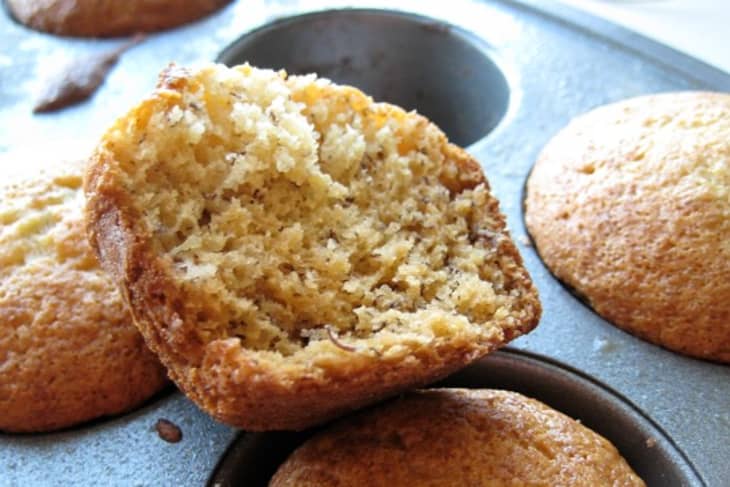Help! How Do I Fix My Muffin Recipe?
Rachel, one of our readers, has been getting into baking and is hoping for some help with one of her recipes:
Hi, Kitchn! Lately I’ve been attempting to cook more at home, and I’m also making my first attempts at baking from scratch. Today was an easy start – banana muffins. The recipe I used is as follows…
Banana Muffins
Mix:
3 mashed bananas
1 beaten egg
3/4 c. sugar
Then add:
1 tsp baking soda
1 tsp baking powder
1/2 tsp salt
1 1/2 c. flour
(I also added some sour cream and a dash of vanilla extract.)
then bake 20 min at 375°
My muffins turned out tasty, although they were definitely more of a banana bread consistency than a cake-y muffin that I was hoping for. What modifications can I make to this recipe to get a more moist muffin?
Thanks!
This is a very interesting question, Rachel! And a tricky one, too, since modifying baking recipes gets into some kitchen chemistry. We love playing around with recipes until they’re just the way we like them, and we’re excited to give this one a try.
Here’s what we’re assuming from your e-mail: The flavor of these muffins was good, but the consistency was dense, moist, and very tender. We’re thinking that you want a slightly drier muffin with a lighter crumb.
First of all, try cutting back on the leavening. For every cup of flour, you only need 1 teaspoon of baking powder or 1/4 teaspoon of baking soda. Too much leavening actually results in a denser texture because the cake rises and then collapses back onto itself when the gases escape.
For this recipe, we’d recommend using 1/2 teaspoon of baking powder and 1/4 teaspoon of baking soda. If you’d like a slightly more sour flavor in your muffins, you could also skip the baking soda altogether and simply use 1 1/2 teaspoons of baking powder. (The reason why some recipes use both powder and soda is because soda neutralizes acidity when the recipe contains a lot of acidic ingredients, like your sour cream.)
By the way, stick to about 1/2 cup of sour cream to keep the proportion of liquids in balance. You can add a little more if the batter seems really thick and dry.
Next, try adding a little fat. You don’t need much – maybe 2-3 tablespoons of butter – but this will help make the muffins lighter. Butter helps to hold the little air bubbles that expand while the muffins are in the oven and create that airy texture.
Finally, you can play around with how you mix together the ingredients. Surprisingly, this can make a big difference in the final texture!
If you end up adding fat, make sure it’s at room temperature and then use a hand mixer to cream it a little. Add in the sugar and cream them together until the mixture is light-colored and fluffy – like frosting! Next, incorporate the egg into the butter/sugar mixture. Finally, add in the mashed bananas, sour cream, and vanilla.
In a separate bowl, combine the flour, baking soda, baking powder, and salt. Add this to the liquids a bit at a time until the two are just barely combined and you don’t see anymore flour. This should form a shaggy batter. If it’s still very liquidy, try adding another 1/4 cup of flour.
If you don’t have a mixer, just do the best you can by hand. The texture will end up being a bit more dense than if you had a mixer, but should still be fluffier than before.
Rachel, please let us know what you end up doing and how your muffins turn out! Good luck with your baking!
Does anyone else have other suggestions for Rachel to try?
• We referred to both Bakewise by Shirley O. Corriher and On Food and Cooking by Harold McGee in our research for this post.
Related: Baking Lab: Why Did Our Cake Fall Flat?
(Images courtesy of Rachel)
